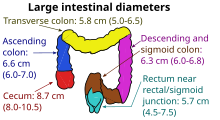Cecum
The cecum or caecum is a pouch within the peritoneum that is considered to be the beginning of the large intestine.[1] It is typically located on the right side of the body (the same side of the body as the appendix, to which it is joined). The word cecum (/ˈsiːkəm/, plural ceca /ˈsiːkə/) stems from the Latin caecus meaning blind.
It receives chyme from the ileum, and connects to the ascending colon of the large intestine. It is separated from the ileum by the ileocecal valve (ICV) or Bauhin's valve. It is also separated from the colon by the cecocolic junction. While the cecum is usually intraperitoneal, the ascending colon is retroperitoneal.[2]
In herbivores, the cecum stores food material where bacteria are able to break down the cellulose. In humans, the cecum is involved in absorption of salts and electrolytes and lubricates the solid waste that passes into the large intestine.[3]
The cecum and appendix are derived from the bud of cecum that forms during week 6 in the midgut next to the apex of the umbilical herniation.[5] Specifically, the cecum and appendix are formed by the enlargement of the postarterial segment of the midgut loop. The proximal part of the bud grows rapidly to form the cecum. The lateral wall of the cecum grows much more rapidly than the medial wall, with the result that the point of attachment of the appendix comes to lie on the medial side.[citation needed] The cecum's position changes after the midgut rotates and the ascending colon elongates, and the accumulation of meconium inside the cecum may result in the latter's increased diameter.[5]
The term cecum comes from Latin (intestinum) caecum, literally 'blind intestine', in the sense 'blind gut' or 'cul de sac'.[6] It is a direct translation from Ancient Greek τυφλὸν (ἔντερον) typhlòn (énteron). Thus the inflammation of the cecum is called typhlitis.
In dissections by the Greek philosophers, the connection between the ileum of the small intestine and the cecum was not fully understood. Most of the studies of the digestive tract were done on animals and the results were compared to human structures.[7]

